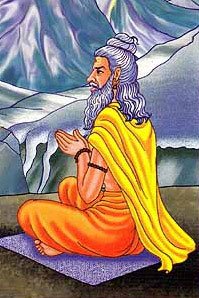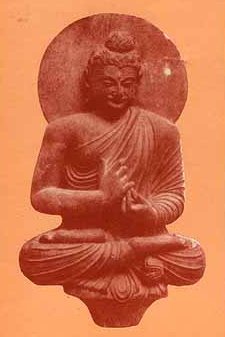Gandika, Gaṇḍikā, Gaṇḍīkā: 9 definitions
Introduction:
Gandika means something in Hinduism, Sanskrit, Buddhism, Pali. If you want to know the exact meaning, history, etymology or English translation of this term then check out the descriptions on this page. Add your comment or reference to a book if you want to contribute to this summary article.
In Hinduism
Purana and Itihasa (epic history)
Source: Cologne Digital Sanskrit Dictionaries: The Purana IndexGaṇḍīkā (गण्डीका).—Apparently a town; to the East of Mālyavat; on the slopes of the Gandhamādhana and the Mālyavata; in the first line Ketumālas; and there is a mahāvṛkṣa Janasa.*
- * Matsya-purāṇa 113. 51: Vāyu-purāṇa 43. 1-4.

The Purana (पुराण, purāṇas) refers to Sanskrit literature preserving ancient India’s vast cultural history, including historical legends, religious ceremonies, various arts and sciences. The eighteen mahapuranas total over 400,000 shlokas (metrical couplets) and date to at least several centuries BCE.
Languages of India and abroad
Pali-English dictionary
Source: BuddhaSasana: Concise Pali-English Dictionarygaṇḍikā : (f.) a hollowed block of wood which is used to serve the purpose of a bell; a gong.
Source: Sutta: The Pali Text Society's Pali-English DictionaryGaṇḍikā, (f.) (a-n. formation from gaṇḍa or gaṇṭha, see also gaṇṭhikā)—1. a stalk, a shaft (cp. gaṇḍī) J.I, 474; DhsA.319 (of the branches of trees: g°-ākoṭana-sadda).—2. a lump, a block of wood (more frequent spelling gaṇṭhikā, q. v.).—3. N. of a plant Vv 354 (=bandhujīvaka VvA.161).

Pali is the language of the Tipiṭaka, which is the sacred canon of Theravāda Buddhism and contains much of the Buddha’s speech. Closeley related to Sanskrit, both languages are used interchangeably between religions.
Sanskrit dictionary
Source: DDSA: The practical Sanskrit-English dictionaryGaṇḍikā (गण्डिका).—
1) A sort of pebble.
2) A kind of beverage.
3) Anything advanced beyond the first stage.
Source: Cologne Digital Sanskrit Dictionaries: Edgerton Buddhist Hybrid Sanskrit DictionaryGaṇḍikā (गण्डिका).—(1) stalk (= gaṇḍa, 1; = Pali gaṇḍikā, gaṇṭhikā): ikṣu-g° (= Pali ucchu-g°) Mahāvastu i.17.11, 12; (2) piece (compare gaṇḍa, 2) or block of wood (also Pali id., more often spelled gaṇṭhikā): gośīrṣacandanasya tisro gaṇḍikā vastreṇa pidhāya Divyāvadāna 31.27; (tisro) gaṇḍikā darśitāḥ 32.2; (3) = gaṇḍī, gaṇḍi, gong: Kāraṇḍavvūha 13.8, read, dharma-gaṇḍikām ākoṭayanti (see ākoṭayati).
Source: Cologne Digital Sanskrit Dictionaries: Monier-Williams Sanskrit-English Dictionary1) Gaṇḍikā (गण्डिका):—[from gaṇḍaka > gaṇḍ] a f. a hill [Scholiast or Commentator] [Mahābhārata vi, 230 and 282]
2) [v.s. ...] = ṣaṇḍa-viśeṣa, Bhagavatī, [xvi, 4 [Scholiast or Commentator]]
3) [v.s. ...] a little knot in the wood (?), [Caraka vi, 18, 77]
4) [v.s. ...] anything advanced beyond the first stage or commencement, [cf. Lexicographers, esp. such as amarasiṃha, halāyudha, hemacandra, etc.]
5) [from gaṇḍ] b f. of ḍaka q.v.
6) Gandikā (गन्दिका):—[varia lectio] for gabd q.v.
7) Gāndika (गान्दिक):—[varia lectio] for gābd.
Source: DDSA: Paia-sadda-mahannavo; a comprehensive Prakrit Hindi dictionary (S)Gaṇḍikā (गण्डिका) in the Sanskrit language is related to the Prakrit word: Gaṃḍiyā.
[Sanskrit to German]
Sanskrit, also spelled संस्कृतम् (saṃskṛtam), is an ancient language of India commonly seen as the grandmother of the Indo-European language family (even English!). Closely allied with Prakrit and Pali, Sanskrit is more exhaustive in both grammar and terms and has the most extensive collection of literature in the world, greatly surpassing its sister-languages Greek and Latin.
See also (Relevant definitions)
Starts with: Gamdikavali, Gandikadhana, Gandikakarayoga.
Ends with: Amaragandika, Anugandika, Aparagandika, Dhammagandika, Kalagandika, Kishkindhagandika, Magandika, Purvapurvanugandika, Pushpagandika, Sutragandika, Yamagandika.
Full-text: Sutragandika, Pushpagandika, Gabdika, Kishkindhagandika, Anugandika, Gandikakarayoga, Kalagandika, Gandiya, Purvapurvanugandika, Gandi, Dhammagandika, Gandikadhana, Gandaka, Ganthika, Ganda, Bhandika, Kishkindha, Lasya.
Relevant text
Search found 9 books and stories containing Gandika, Gaṇḍikā, Gaṇḍīkā, Gandikā, Gāndika; (plurals include: Gandikas, Gaṇḍikās, Gaṇḍīkās, Gandikās, Gāndikas). You can also click to the full overview containing English textual excerpts. Below are direct links for the most relevant articles:
The Padma Purana (by N.A. Deshpande)
Chapter 75 - The Greatness of Gaṇḍikā < [Section 6 - Uttara-Khaṇḍa (Concluding Section)]
Chapter 35 - The Vow of Unmīlanī < [Section 6 - Uttara-Khaṇḍa (Concluding Section)]
Vinaya (3): The Cullavagga (by T. W. Rhys Davids)
Cullavagga, Khandaka 6, Chapter 17 < [Khandaka 6 - On Dwellings and Furniture]
Cullavagga, Khandaka 5, Chapter 8 < [Khandaka 5 - On the Daily Life of the Bhikkhus]
The Brahmanda Purana (by G.V. Tagare)
Chapter 15 - The length and extent of the Earth: Description of Jambūdvīpa < [Section 2 - Anuṣaṅga-pāda]
Kautilya Arthashastra (by R. Shamasastry)
Chapter 2 - March of the Camp < [Book 10 - Relating to War]
Chapter 14 - The Duties of the State Goldsmith in the High Road < [Book 2 - The duties of Government Superintendents]
The Skanda Purana (by G. V. Tagare)
Chapter 1 - Superiority of the Holy Place Badarikāśrama over all Tīrthas < [Section 3 - Badarikāśrama-māhātmya]
Vinaya Pitaka (2): Bhikkhuni-vibhanga (the analysis of Nun’ rules) (by I. B. Horner)